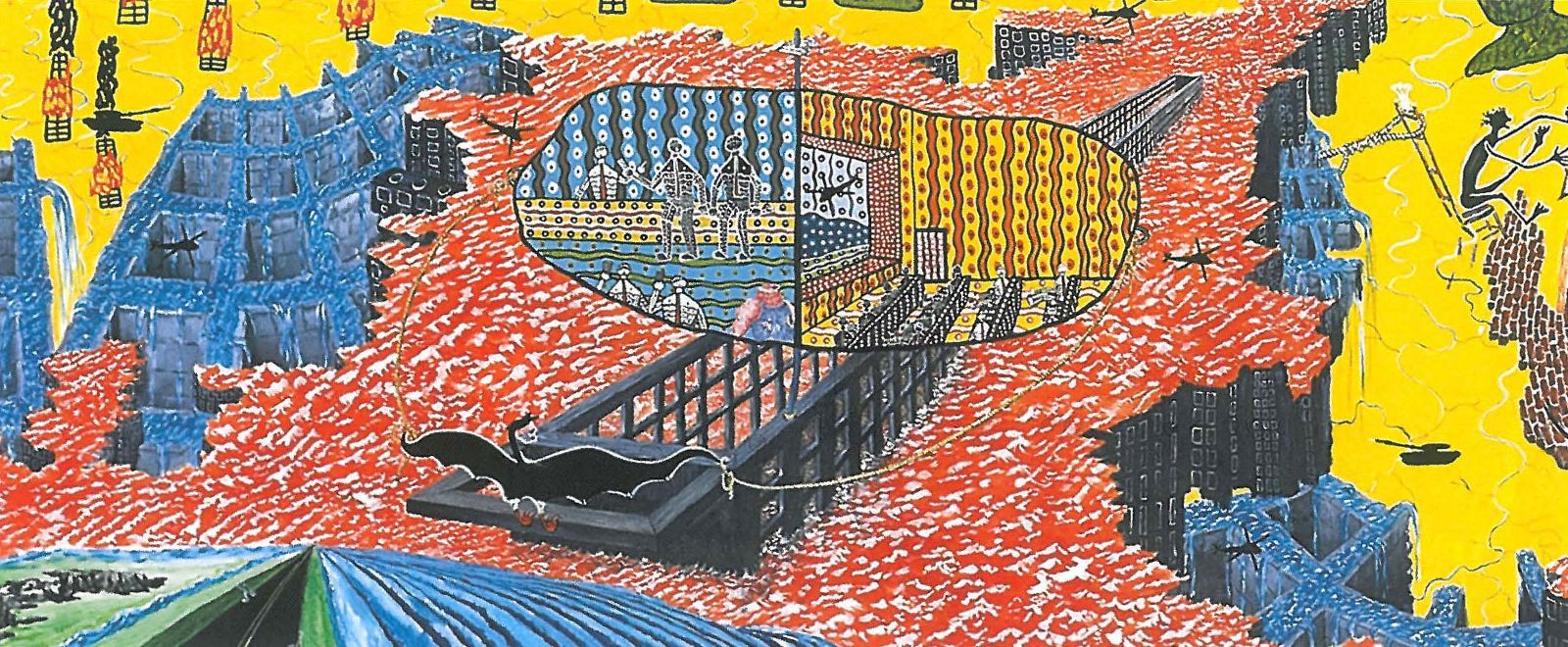
Synergies the exhibition is part of Fusion, a year of activities at the Australian National University exploring the merging of artistic practices and intellectual currents. The exhibition was coordinated by Nigel Lendon, Reader in Visual Arts and Deputy Director School of Art, National Institute of the Arts and Howard Morphy Professor and Director of the Centre for Cross-Cultural Research, both at the Australian National University. A curatorial team comprised of Mary Eagle, Gordon Bull, Geremie Barmé, Roger Benjamin, John E Stanton, Ursula Fredrick, and Ian Maclean assisted these two academics. Each curator wrote for, worked with or nominated the following artists respectively, Robert Campbell Jnr & Tony Coleing, Imants Tillers, William Yang, Kate Beynon, Sang Ye, Tim Johnson, Julie Dowling, Ian Abdulla and Gordon Bennett.
This list of writers and academics from the cross-cultural field, in conjunction with a mostly obvious artist choice, made for an institutionalised, bureaucratic exhibition. It did not, as the catalogue introduction stated problematise the boundaries between cultures, disciplines, art forms or genres. Rather I came away with the distinct impression the dominant players of art history, anthropology and philosophy had neatly resolved it. With the exclusion of Julie Dowling and Kate Beynon, the exhibition read as critically relevant ten years ago.
Pairing artists and writers/curators, along with the binary logic of this culture alongside that of another culture, as the point of cross-cultural experience, affirmed the formation of parallel cultural trajectories over their crossing. In effect, this style of presentation did nothing for the complexities of contemporary cultural negotiation. Instead of locating the conundrums of cross cultural existence – fluid, dynamic and never static - this exhibition was formal and polished, leaving most of the claims to cross-cultural experience dry and lifeless.
For example, work by Imants Tillers in this exhibition left this viewer more convinced of its inherent authorial absorption. I found no currency in his style of critique. This work is self-consciously theoretical motivating little social agency. Its scale reinforces a homogenising heroic sensibility. The straightforward placement of a work by Robert Campbell Jnr with a work by Tony Coleing despite its collaborative intent, maintained the parallel trajectory issue.
The rewarding aspects of this exhibition were the subtle social complexities located by William Yang, Julie Dowling, Kate Beynon and Sang Ye with Geremie Barmé. In visually scouring William Yang's family history, the audience was treated to a persuasive evocation of a specific cultural existence ie the rural Chinese Australian.

The works of Yang, Beynon and the collaborative installation by Sang Ye and Geremie Barmé provided a thoughtful intercession of cross-cultural artistic practice. Ye and Barmé's paper houses were a delight and beckoned viewers to surround themselves in the work by sitting in the house. Ye and Barmé aligned this work with a performative interpretation of contemporary cultural existence avoiding a strict bipolar comparison of mine and yours, us and them and so forth.
Kate Beynon's characteristic animations analysing contemporary social issues were a meaningful inclusion in this exhibition. Occupying the entire back gallery, Beynon's invented female action figure, Li Ji, explores issues across cultures through gender roles and hybridity with a political currency that is familiar to your average pre-teen or adolescent. Other works by Beynon included a somewhat naïve video piece and her well-known Chinese pipe cleaner characters. Beynon and Yang, like Sang Ye and Barmé, worked the conundrums of cross-cultural with greater efficacy and compulsion.
In all, this exhibition disappointed. Individually the works are strong in and of themselves. As is the catalogue for the exhibition. However, as a research school project I expected a higher level of critical engagement with the issue of cross-cultural experience. Presenting the obvious top ten of the field in this way, in such a formulaic manner is worthy of an ambitious undergraduate honours student rather than the two coordinators of this exhibition.












